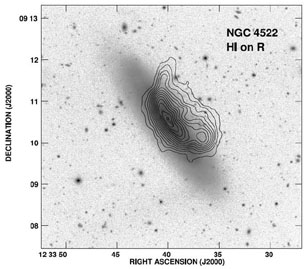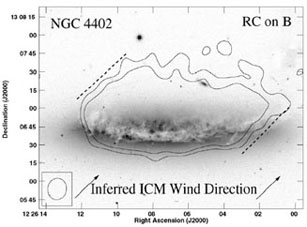


A galaxy passing through the ICM feels an external pressure. This
pressure depends on the ICM density
 ICM
and the relative velocity vrel of the galaxy and the ICM.
Gunn & Gott
(1972)
suggested this process already many years ago. They
also gave a frequently used prescription for the radius r beyond
which the gas of a galaxy is stripped, depending on the ram pressure and
the galactic gravitational restoring force. The implicit condition on
r reads
ICM
and the relative velocity vrel of the galaxy and the ICM.
Gunn & Gott
(1972)
suggested this process already many years ago. They
also gave a frequently used prescription for the radius r beyond
which the gas of a galaxy is stripped, depending on the ram pressure and
the galactic gravitational restoring force. The implicit condition on
r reads
 |
(1) |
with pram being the ram pressure, G the
gravitational constant,
 star the
stellar surface density,
star the
stellar surface density,
 gas the surface
mass density of the galactic gas.
gas the surface
mass density of the galactic gas.
Nowadays the process of ram-pressure stripping receives more and more attention. There is now much observational evidence of stripped galaxies. In the Virgo cluster several examples of spiral galaxies affected by ram-pressure stripping have been found by H I observations (Cayatte et al. 1990, Veilleux et al. 1999, Vollmer et al. 1999, Vollmer 2003, Kenney et al. 2004, Vollmer et al. 2004a, Vollmer et al. 2004b, Koopmann & Kenney 2004, Crowl et al. 2005, see Fig. 1). Furthermore in Virgo elliptical galaxies stripping features have been discovered (e.g. Rangarajan et al. 1995, Lucero et al. 2005, Machacek et al. 2006a). Also in Coma and other clusters and groups evidence for ram-pressure stripping has been found (Bravo-Alfaro et al. 2000, Bravo-Alfaro et al. 2001, Kemp et al. 2005, Rasmussen et al. 2006, Levy et al. 2007). Deficiency of H I has been reported as evidence for ram-pressure stripping (Vollmer & Huchtmeier 2007). It is even possible that the H I plume of the galaxy NGC 4388, that extends to more than 100 kpc, is a ram-pressure stripping feature (Oosterloo & Van Gorkom 2005). In the galaxy NGC 7619 stripping features have been found showing a high metallicity in the gas tail behind the galaxy (Kim et al. 2007). The galaxy ESO 137-001 in the cluster Abell 3627 shows a long tail with several star formation regions suggesting that ram-pressure triggers star formation not only within the galaxy but also in the stripped material (Sun et al. 2007). Recently ram-pressure features have also been found in distant clusters (Cortese et al. 2007).
 |
 |
Figure 1. Two examples of galaxies affected by ram-pressure stripping in the Virgo cluster. Top: H I gas (contours) and stellar light (grey scale, R-band) of NGC 4522. While the stellar distribution looks undisturbed the gas is bent back due to ram-pressure stripping (1.4 GHz radio continuum contours on B-band, from Kenney et al. 2004). Bottom: Similar features in NGC 4402 (from Crowl et al. 2005). |
For a review on ram-pressure stripping and H I deficiency see Van Gorkom (2003).
As ram-pressure stripping is such a common process, there are many simulations in which the stripping process of galaxies was calculated for different types of galaxies: spirals, ellipticals and dwarfs (Abadi et al. 1999, Quilis et al. 2000, Mori & Burkert 2000, Toniazzo & Schindler 2001, Schulz & Struck 2001, Vollmer et al. 2001, Hidaka & Sofue 2002, Bekki & Couch 2003, Otmianowska-Mazur & Vollmer 2003, Acreman et al. 2003, Marcolini et al. 2003, Roediger & Hensler 2005, Roediger & Brüggen 2006, Roediger et al. 2006, Mayer et al. 2006, Vollmer et al. 2006, see Fig. 2). The simulations confirm that the process is acting in the expected way. Starting from the outer parts of the galaxy gas is stripped off. Part of this gas is not bound to the galaxies anymore and left in a wide (fragmenting) tail behind the galaxy. Recently even the increase of star formation in and behind the galaxy caused by ram-pressure stripping has been found in simulations (Kronberger et al. 2008a, Kapferer et al. 2008). Brüggen et al. (2008) found that more than half of the cluster galaxies have experienced ram-pressure stripping and hence a considerable fraction of galaxies in a cluster at the present epoch has suffered a substantial gas loss.
 |
Figure 2. Simulation of a galaxy in the process of ram-pressure stripping with gas density (grey scale, ranging from 4 × 10-29 to 1 × 10-27 g cm-3), pressure (black contours, logarithmically spaced from log(p) = -3.6 to log(p) = -2.6 in units of 10-24 keV cm-3) and velocity vectors (white when Mach number > 1, and black otherwise) at three different times. A cut through a 3D simulations is shown with coordinates in kpc. Due to the ram pressure of the ICM the galaxy loses more and more of its gas (from Toniazzo & Schindler 2001). |
An analytical model has been developed to describe ram-pressure stripping for galaxies of different morphologies in different environments (Hester 2006). It describes the stripping of a satellite galaxy's outer H I disk and hot galactic halo.
It was tested with simulations whether the simple, widely used criterion by Gunn & Gott (1972) is a good estimate for the mass loss. Generally it is found that the criterion is a good estimate for the mass loss (Roediger & Brüggen 2007b, Kronberger et al. 2008a) when simulations and analytic estimates are compared for the same conditions (see Jachym et al. 2007 for a comparison with different conditions) - a quite surprising result given the simple assumptions of the criterion, that do not even take into account dark matter.